The Moon Moves into Morning, a New Bright Comet, Jupiter Sports Spots, a Very Venus Week, and Ogling Ophiuchus!
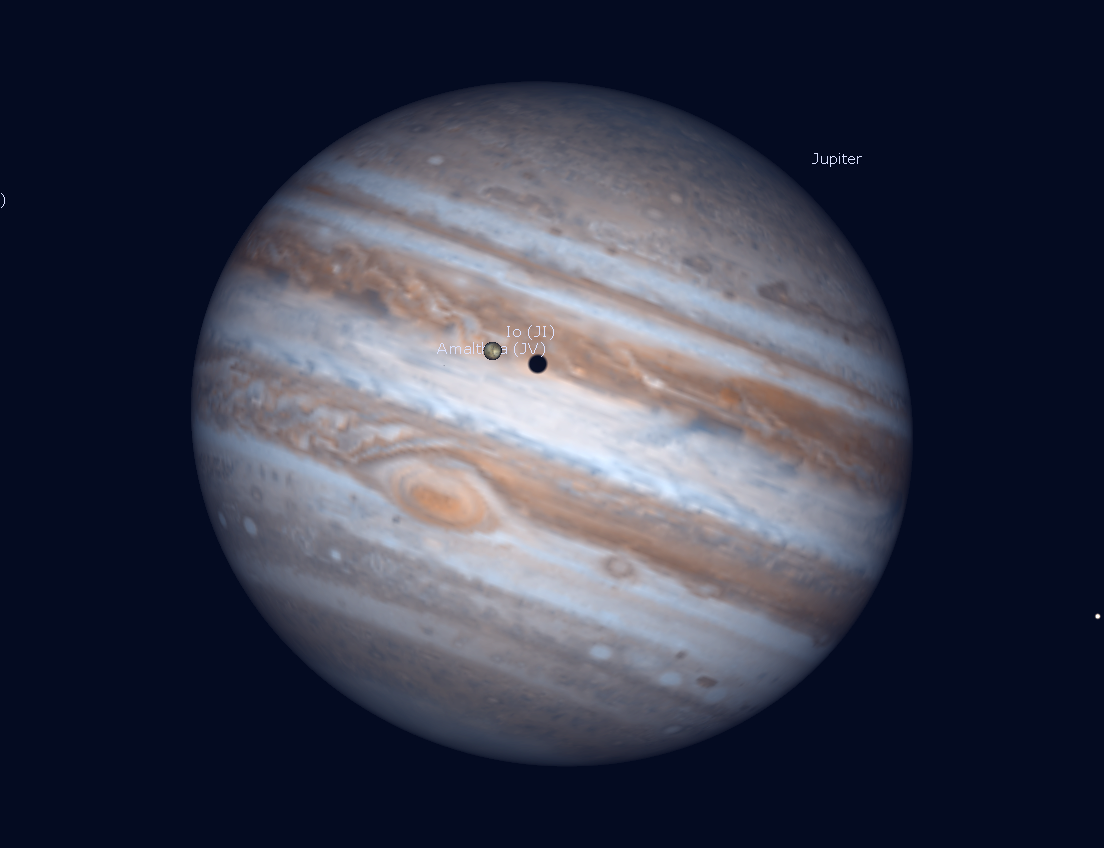
This simulated view of Jupiter shows the transit of Jupiter’s moon Io and its shadow across Jupiter, accompanied by the Great Red Spot, on Tuesday, July 7 at 2:40 am EDT. A good backyard telescope will let you view the 2.5-hour event, although a telescope might flip and/or mirror this view.
Hello, July Stargazers!
Here are your Astronomy Skylights for the week of July 5th, 2020 by Chris Vaughan. Feel free to pass this along to your friends and send me your comments, questions, and suggested topics. You can also follow me on Twitter as @astrogeoguy! Unless otherwise noted, all times are expressed in Eastern Time.
I can bring my Digital Starlab portable inflatable planetarium to your school or other daytime or evening event, or teach a session online. Contact me through AstroGeo.ca, and we’ll tour the Universe or the Earth’s interior together!
What a week it will be for Venus lovers. Our sister planet will reach maximum brightness in the eastern pre-dawn sky while it crosses through the stars of Taurus. Meanwhile, the waning moon will pose with Jupiter and Saturn, and then swing towards last quarter – leaving evening skies progressively darker for everyone to take a tour through the thirteenth zodiac constellation. New Comet NEOWISE should be bright enough to see before dawn near Capella. And you can observe seven planets, plus Pluto, at the same time in the pre-dawn! Here are your Skylights!
Bright Comet Alert!
At long last, we have a comet with a tail – and anyone can see it, if they are willing to get up before dawn. Comet C/2020 F3 NEOWISE was discovered on March 27 by the NEOWISE space telescope. It swung around the sun on July 3 (its perihelion), and it has now become visible to observers in the Northern Hemisphere. The comet is still relatively close to the sun, so it’s only visible for about 30 to 45 minutes each morning – ranging from shortly after the time it rises to until the morning sky brightens enough to hide it.
You can use your unaided eyes to see it, or look through binoculars and telescopes. The best way to see the comet is to check to see whether your skies will be clear to the east before dawn, and then plan to be outside about 90 minutes before sunrise in your local time zone. You’ll need a safe spot with a low northeastern horizon that is free of trees or buildings. A site without artificial light will help.
Comets move across the sky – more rapidly when they are near perihelion. This one is climbing daily and shifting to the left, compared to the stars around it. Tomorrow morning (Monday), the comet will rise at about 3:30 am local time (it varies by your latitude). It will be located about 1.5 fist diameters below (or 15° to the celestial southeast of) the very bright star Capella.
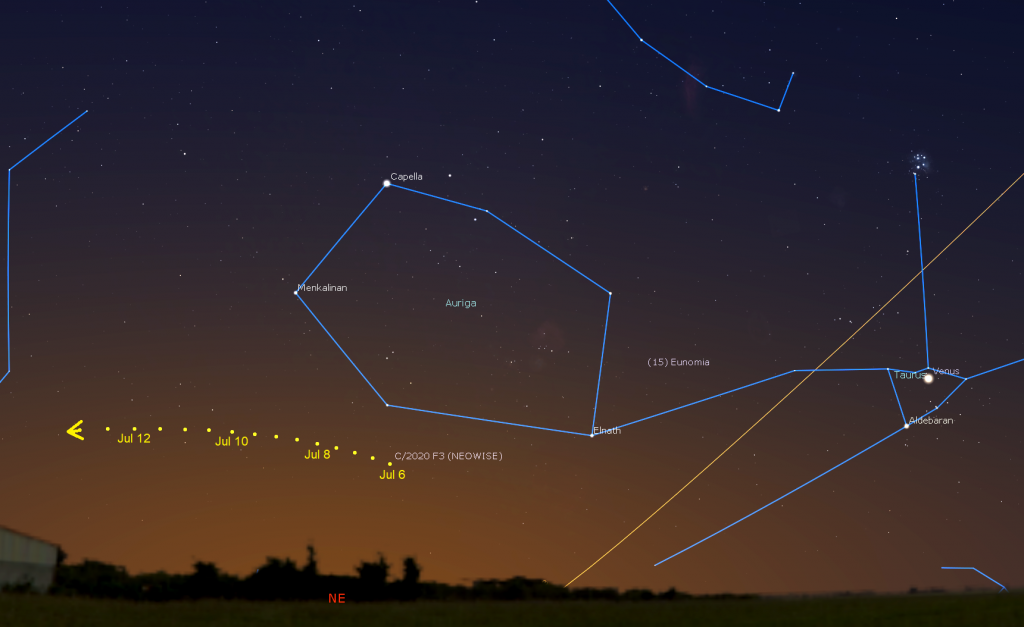
By next Sunday morning, the comet will rise about an hour earlier. It will have moved to sit nearly two fist diameters to the lower left (or 19° to the celestial southeast) of Capella. The earlier rise time will place the comet higher in a darker sky, making it easier to see – but it will also be diminishing in brightness every morning as it pulls away from the sun’s warmth.
What you should expect to see is a small, bright, fuzzy spot, possibly with an orange hue, and a fainter tail that extends upwards away from the sun.Let me know if you see it, or get a photo of it!
The Moon
Since the moon was full early this morning (Sunday), it will spend this week moving to its last quarter phase next Sunday. During this period the moon will be waning in illuminated phase and rising in the middle of the night. That will leave the evening skies darker around the world. You’ll see the moon in the eastern sky before dawn and then in the southern daytime sky until mid-morning.
Have you noticed that the bright, full moon wasn’t very high in the sky this past weekend? The sun, which constantly travels along the ecliptic, and the moon in its orbit, both follow roughly the same great circle around the sky. Near the June solstice, the northern axial pole of Earth is tipped in the direction of the sun. As we in the Northern Hemisphere “bow” to the sun, it and the ecliptic are lifted extra high in our noon-day sky. Conversely, twelve hours later, the night-time ecliptic is held extra low in the sky – keeping the full moon down in the lower third of the sky. The effect is like a see-saw – sun high, full moon low, and vice versa. That same phenomenon causes the December full moon to shine nearly overhead, while the noon-day sun sits low in the sky.
Photo op! When the full moon rises over the southeastern horizon at dusk tonight (Sunday evening), it will form a neat triangle below (to the celestial south of) Jupiter and Saturn. The moon and two planets will fit within the field of view of binoculars and will produce a lovely wide field photograph when composed with interesting foreground scenery. Over the course of the night, the diurnal rotation of the sky will shift the moon to the planets’ left, and the moon’s orbital motion will carry it closer to Saturn than Jupiter.
On Monday and Tuesday night, the waning gibbous moon will traverse the dim stars of Capricornus (the Sea-Goat). On Wednesday and Thursday it will visit Aquarius (the Water-Bearer). In the southeastern sky during the hours before dawn on Saturday, the moon will shine near Mars. Look for the moon positioned a palm’s width to the right (or 7° to the celestial west) of the bright, red-tinted planet. As the pair crosses the sky together, the moon’s orbital motion will carry it noticeably closer to Mars by dawn. The same movement will cause the moon to hop to the left-hand (eastern side) of Mars on Sunday morning. Observers at Middle Eastern longitudes can see the moon pass just below (or less than three degrees south of) Mars on Sunday.
The moon will formally reach its last quarter phase at 7:29 pm EDT, or 23:29 Greenwich Mean Time, on Sunday, July 12. At last quarter, the moon always rises near midnight and then remains visible in the southern sky during morning daylight. The relative positions of the Earth, sun, and moon cause us to see the moon half-illuminated – on its western (left-hand) side. The last quarter moon is also positioned ahead of the Earth in our trip around the sun. About 3½ hours later, Earth will occupy that same location in space. After this phase, the waning moon will traverse the final quarter of its orbit around the earth, on the way to new moon.
The Planets
If you get outside early to catch the comet, your eye will definitely be caught by brilliant Venus, which will rise in the east at about 3:30 am local time this week. Between July 3 and 12, Venus’ orbital motion will carry it directly through the Hyades star cluster. That’s the large, triangular grouping of stars that forms the face of Taurus (the Bull). Try looking with unaided eyes while the sky is still somewhat dark, around 4:30 am local time – or use binoculars, which will nicely frame the planet and the cluster’s stars surrounding it.
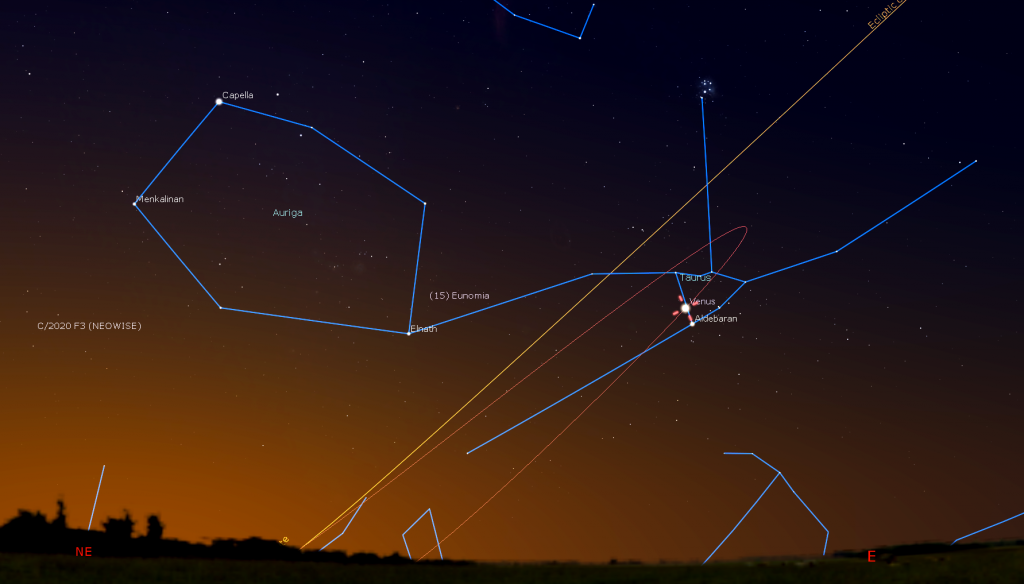
Venus’ motion offers an opportunity to easily see the daily motion of a planet. On Monday morning, Venus will be tucked just inside the top edge of the triangle. By next Sunday, July 12 the bright planet will exit the left-hand (eastern) side of the triangle while passing a finger’s width above (or 57 arc-minutes to the north of) Taurus’ brightest star, Aldebaran. For several mornings centered on July 12, that star and Venus will appear together in the field of view of backyard telescopes at medium magnification, with Venus displaying a crescent phase.
As a bonus, or perhaps a further incentive to set the alarm, in the early hours of Friday, Venus will reach its greatest illuminated extent for the current morning apparition. In a telescope, the planet will show a 27%-illuminated waxing crescent phase and an apparent disk size of 37 arc-seconds. Even with its less than fully-illuminated disk, Venus’ nearness to Earth of only 0.4502 Astronomical Units (67.35 million km) will boost its brightness to a brilliant magnitude -4.47. (The more negative the magnitude value, the brighter the object. The sun is magnitude -26.7!)
Have you seen Jupiter and Saturn dancing across the sky after they rise together in late evening? This week, the very bright, white speck of Jupiter will rise over the east-southeastern horizon at about 9 pm in your local time zone. Dimmer, yellow-tinted Saturn will follow it about 15 minutes later. (Every week, they will rise about half an hour earlier.) For the rest of this year, those two gas giant planets will dance across the sky together, with Saturn on Jupiter’s left (east). Look for the stars of Sagittarius (the Archer) and the Milky Way off to their right (west).
Jupiter might catch your eye through a southerly window during the wee hours of the night. In the Greater Toronto Area and at comparable latitudes on Earth, the two planets will only ascend to about 24 degrees above the horizon when they lay due south at 1:30 am local time. Just before dawn you’ll find them just over the southwestern horizon – and preparing to set. Saturn will vanish into the brightening sky before Jupiter, but you could try to recover it with binoculars.
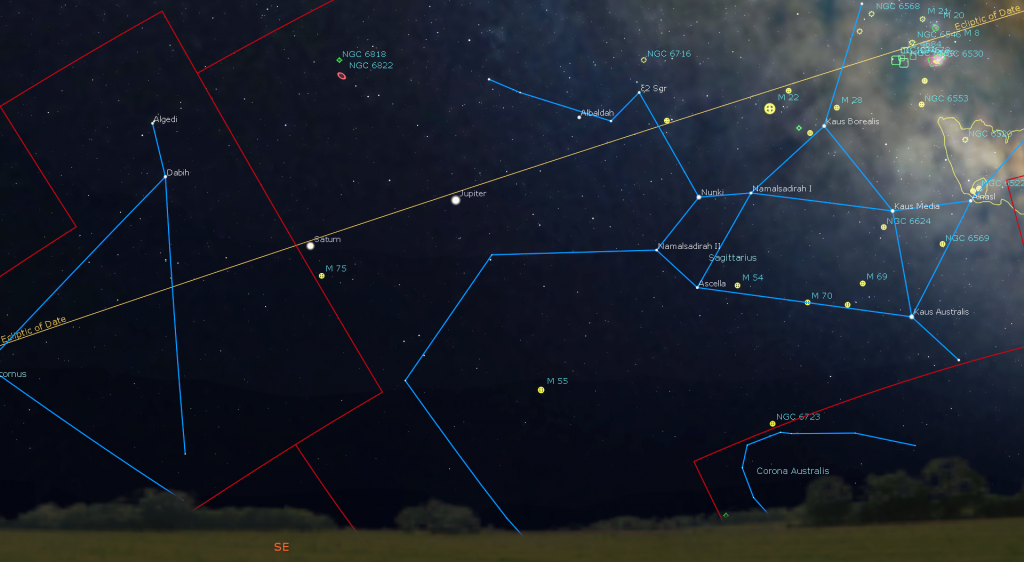
For several weeks, Jupiter and Saturn have been positioned above, and to either side of, a globular star cluster named Messier 75 (or NGC 6864). The magnitude 9.2 cluster should normally be visible in binoculars and backyard telescopes as a small, fuzzy patch – but this weekend’s still-bright moon will suppress it, so try looking in a day or two. This week, the cluster will be located approximately a thumb’s widths below (or 1.5 degrees to the celestial south of) Saturn. Every morning, the planets’ orbital motions will carry them a little bit to the right (west) compared to the cluster. Next week they’ll begin to leave it behind them.
Even binoculars will reveal Jupiter’s four large Galilean moons named Io, Europa, Ganymede, and Callisto as they dance around the planet from night to night. And a modest-sized telescope will show Jupiter’s brown equatorial belts and the famous Great Red Spot. In the Eastern Time zone, the Great Red Spot will be crossing the planet’s disk starting after dusk on Tuesday and next Sunday, starting in late evening on Thursday, and during the wee hours of Friday.
From time to time, the round, black shadows cast onto Jupiter by its Galilean moons are visible in amateur telescopes as they cross (or transit) the planet’s disk for a few hours. Starting at 1:36 am EDT on Tuesday, observers in the Americas can see Io’s shadow traverse the planet, accompanied by the Great Red Spot! Io’s shadow will cross Jupiter between 1:36 am and 3:53 am EDT. The spot will complete its passage after the shadow moves off the planet. On Wednesday evening at dusk Io’s shadow will be completing a transit. Callisto’s large shadow will be visible on Jupiter, also with the Great Red Spot, on Thursday from 2:34 am EDT until dawn. And the large shadow of Ganymede will cross Jupiter on Friday between 2:30 am EDT and dawn.
Dust off your telescope! Even a small telescope will show Saturn’s rings and several of its brighter moons – especially its largest moon, Titan! Because Saturn’s axis of rotation is tipped about 27° from vertical (a bit more than Earth’s axis), we can see the top surface of its rings, and its moons can arrange themselves above, below, or to either side of the planet. During this week, Titan will migrate counter-clockwise around Saturn, moving from below Saturn tonight (Sunday) to the upper right of the planet next Sunday. (Remember that your telescope will flip the view around.)
Mars has been speeding eastward along the ecliptic, causing it to rise long after Jupiter and Saturn. This week, Mars will be rising shortly after midnight local time, and will remain visible as a prominent reddish dot until dawn, when it will be positioned about 3.5 fist diameters above the southeastern horizon. Mars is steadily increasing in disk size and brightness because Earth is travelling towards it this summer. You can’t miss it. Aside from the moon on the coming weekend, nothing else near Mars is anywhere as bright (nor as red).
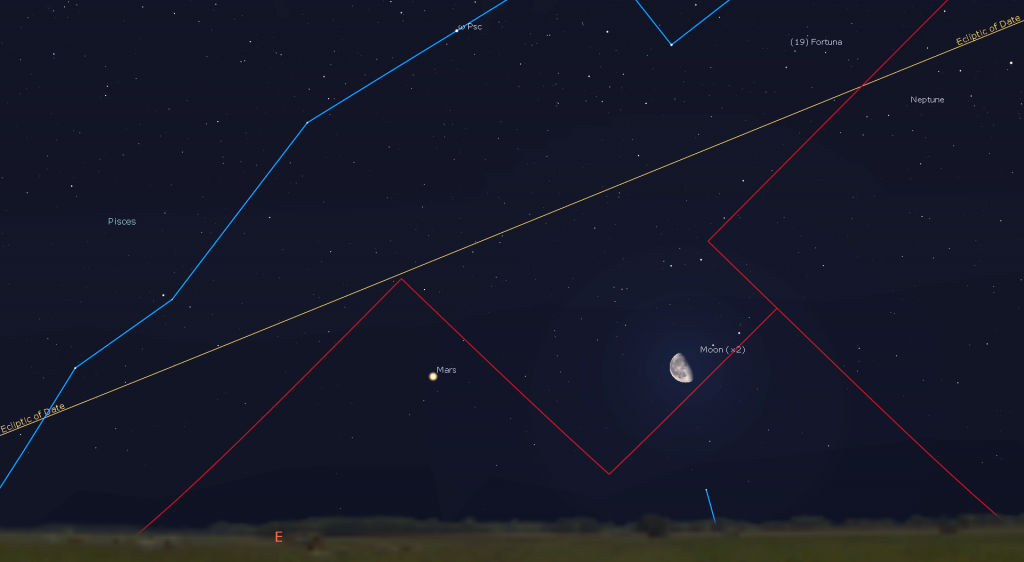
The dim and distant outer planets Uranus and Neptune are east and west of Mars, respectively. But I’ll hold off describing where they are until they are visible at a more convenient time.
By the way, we’re now in a period where, after Venus rises at 3:30 am local time, you can observe seven planets (which includes Earth, by looking down) at the same time – plus the dwarf planets Ceres in Aquarius and Pluto below Jupiter, if you have a large enough telescope! Once Mercury appears next week, it’ll be possible to see all eight classical planets!
Ogling Ophiuchus
By the end of this week, the moon’s move to morning will leave the evening sky worldwide nice and dark for sky-watching. Let me introduce you to the lesser-known constellation Ophiuchus. But first – some zodiac-talk.
The twelve constellations of the Zodiac are only special because the great circle of the Ecliptic carries the sun through each of them in turn. The Sun spends varying amounts of time in each constellation, and those dates repeat every year. For example, in the present era, the sun traverses the constellation of Gemini (the Twins) from June 21 to July 19 every year. Remember, the sun isn’t moving – it’s Earth’s motion around the sun that makes it appear to change location with respect to the fixed distant background stars.
If you’re an astrology enthusiast, you’ll be wondering by now – why is the sun traversing Gemini in June and July, when the Gemini “star sign” is for birthdays from May 22 to June 21? Well, thousands of years ago, when astrology was formulated by the Greeks and Babylonians, the sun traversed Gemini during that part of the year. It’s one of many reasons why most astronomers place no value in astrology, whatsoever. By the way – if you have an astronomy app or program that allows the year to be changed, you can prove this for yourself by setting the app to noon, centring on the sun, and then changing the date to June 25th, 16 AD. The sun will hop into Cancer (the Crab), which sits east of Gemini!
Most of the Zodiac constellations are inconspicuous – if not nearly invisible in urban skies. Aries (the Ram) has two decently bright stars that form a little stick, while Cancer, Pisces (the Fishes), Aquarius (the Water Bearer), and Capricornus (the Goat) are seriously tough to make out – unless you travel to dark skies. A few of them, Gemini (the Twins), Taurus (the Bull), Scorpius (the Scorpion), and Leo (the Lion), have very bright stars that form easily recognizable shapes. The rest of them fall into the medium-bright range.
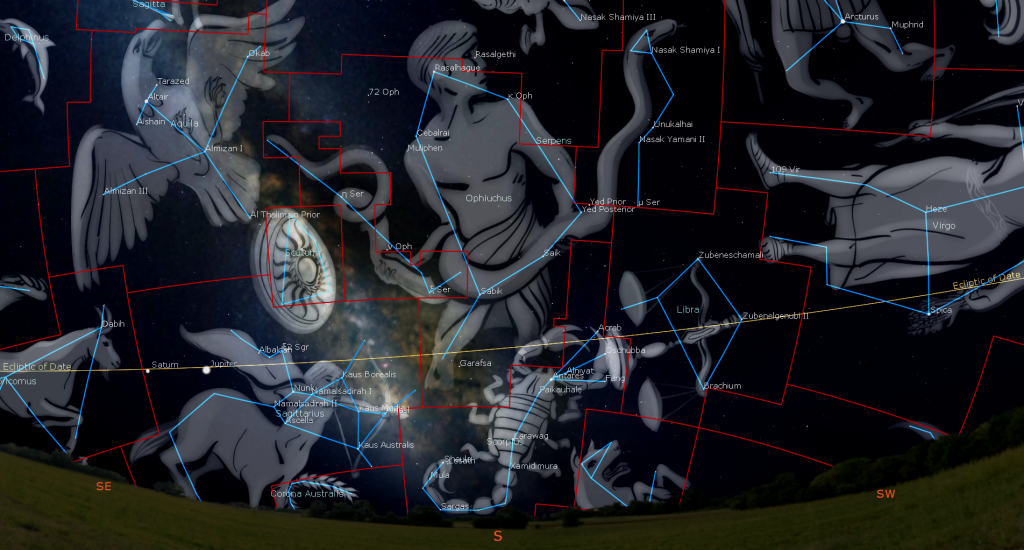
Another fact may surprise you. There is a thirteenth zodiac constellation – and June is a prime month to observe it. Ophiuchus (“Oh-phee-YOU-cuss”), the Serpent Bearer is a huge constellation (11th largest by area) that sits above and between the Teapot asterism of Sagittarius (the Archer) and Scorpius, and sits below Lyra (the Lyre) and Hercules. The ecliptic crosses the southernmost (lower) stars of Ophiuchus, but Opiuchus has never been considered part of the zodiac because that would exceed the special system of 12 sky divisions important to ancient astrologers. If it were included, December babies would be Ophiuchans! In China, Ophiuchus is considered part of 天市左垣(Tiān Shì Zuǒ Yuán), Left Wall of the Heavenly Market Enclosure.
Ophiuchus’ stars are only moderate in brightness – so it’s another constellation that is better to trace out when the sky is darker. The constellation’s shape resembles a large, upright box (26° tall and 16° wide) with a pointed triangle on the upper edge. (Think of a Dalek from Doctor Who, but without the plunger.) The constellation’s brightest star, Rasalhague “the head of the serpent charmer”, marks the peak of the triangle. The star sits below, and about midway between, very bright star Vega and Antares. The latter is the reddish star that is sitting a fist’s diameter to the right of Jupiter this summer.
Immediately east and west of the main body of the Serpent-Bearer are two long sections of a separate, split-in-two constellation named Serpens. It’s the Serpent that Ophiuchus is bearing! The western (right) half is called Serpens Caput (the Snake’s Head), and the eastern (left) portion is Serpens Cauda (the Snake’s Tail).
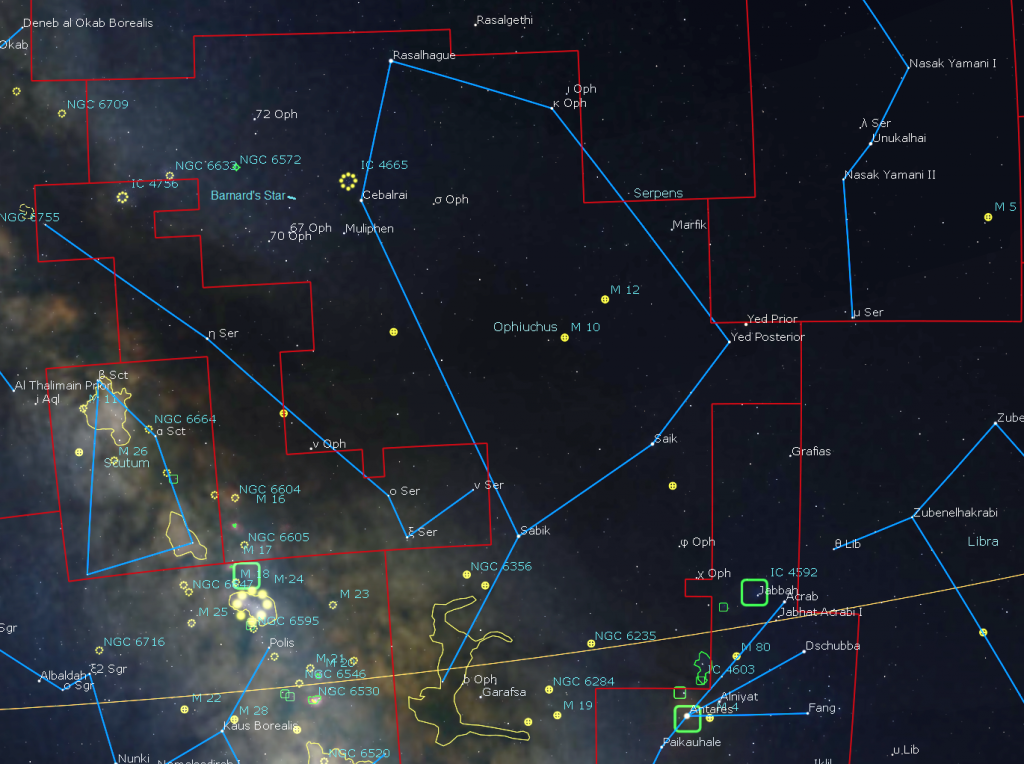
From east to west (left to right in the Northern Hemisphere), the stars forming the bottom of Ophiuchus’ box are: medium bright Sabik “the preceding one”, dimmer Zeta (ζ) Ophiuchi, and two dimmer stars a finger width apart named Yed Prior “leading hand” and Yed Posterior “trailing hand” which mark the western hand. About a palm’s diameter to the upper left of the two Yeds is Marfik “the elbow”. Sabik is the star that Uranus’ northern axis of rotation points towards – the role played by Earth’s pole star, Polaris!
You’ll need an astronomy app and a small telescope to see it, but Ophiuchus is home to Barnard’s Star – a magnitude 9.5, red dwarf located six light-years away from us. It is the fourth closest known star, and the closest star visible from the northern hemisphere. Barnard’s Star sits 3.5 finger widths to the left (or celestial east) of Cebalrai ”shepherd’s dog”, Ophiuchus’ eastern shoulder star. Because it is so close to our solar system, we can actually watch Barnard’s Star travel through the galaxy in a process known as proper motion. It moves about half the moon’s diameter in a human lifetime. A few medium-bright stars located extending to the left of Cebalrai form the gentleman’s pipe or flute (or the Dalek’s disruptor).
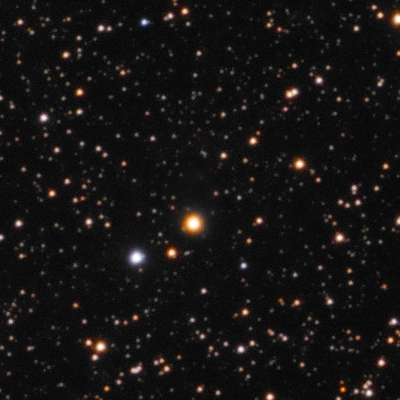
Because Ophiuchus sits just above the plane of the Milky Way, it is chock full of globular clusters – spherical, tightly packed groups of stars that orbit our galaxy tens of thousands of light-years away from us. A large, reasonably bright one designated Messier 10 sits just about where the Serpent-Bearer’s belt buckle would be. You can see these clusters in binoculars or a small telescope, especially from a dark sky site.
Use binoculars to find the small, bright, open star cluster named IC 4665 located just to the upper left (or celestial north) of Cebalrai. The Dark Horse, or Prancing Horse, is a dark region of the Milky Way that surrounds Ophiuchus’ eastern foot, a star named Garafsa or Theta (θ) Ophiuchi. Measuring a fist’s diameter tall and several finger widths across, it can be captured in long exposure images. It can be seen visually from southerly latitudes, where the constellation climbs higher in the sky.
The southeastern (or bottom) part of Ophiuchus dips into the Milky Way – so there are more star clusters there. By 11 pm local time, the centre of Ophiuchus is positioned due south and about halfway up the sky. Let me know if you check it out!
Public Astro-Themed Events
Every Monday evening, York University’s Allan I. Carswell Observatory runs an online star party – broadcasting views from four telescopes/cameras, answering viewer questions, and taking requests! Details are here. Their in-person Wednesday night viewing has been converted to online via the observatory Youtube channel, where they offer free online viewing through their rooftop telescopes, including their brand new 1-metre telescope! Details are here.
Our David Dunlap Observatory Saturday night events may be cancelled, but we’re still pleased to offer the next best thing – a free online talk by Dr. Rachel Ward-Maxwell, Researcher-Programmer in Astronomy and Space Sciences at the Ontario Science Centre. She’s amazing! Tune in to the RASC Toronto Centre’s YouTube channel at 7:30 pm EDT on Saturday, July 11 to see her talk entitled Star Light, Star Bright. More information can be found here.
My Insider’s Guide to the Galaxy webcasts with Jenna Hinds of RASC National resume on Tuesday, July 14 from 3:30 to 5 pm EDT. For that session, we’ll have fun exploring the summer Milky Way, and how you can see its delights yourself. Details and the schedule are here.
The Canadian organization Discover the Universe is offering astronomy broadcasts via their website here, and their YouTube channel here.
On many evenings, the University of Toronto’s Dunlap Institute is delivering live broadcasts. The streams can be watched live, or later on their YouTube channel here.
The Perimeter Institute in Waterloo, Ontario has a library of videos from their past public lectures. Their Lectures on Demand page is here.
Keep looking up, and enjoy the sky when you do. I love questions and requests. Send me some!